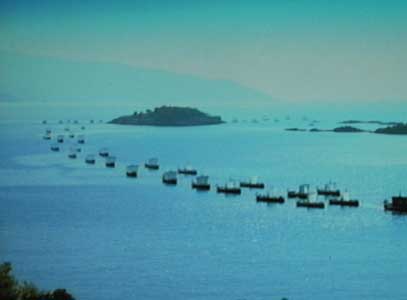.

The Catalogue of Ships (νεῶν κατάλογος; neōn katalogos) is a passage in Book II of Homer's Iliad (2.494-759) which lists the contingents of the Achaean army which sailed to Troy. The catalogue gives the name of the leader of each contingent, describes his home city, and gives the number of ships he led to Troy. A similar, though shorter, catalogue of the Trojans and their allies follows (2.816-877).
In the debate since antiquity over the Catalogue of Ships, the core question has concerned the extent of historical credibility of the account, whether it was written by Homer himself, whether it reflects a pre-Homeric document or memorized tradition, surviving perhaps from Mycenaean times, or whether it is a result of post-Homeric development.[1]
If taken to be an accurate account, the Catalogue provides a rare summary of the geopolitical situation in the region in either the Bronze Age or the eighth century BC. Following Milman Parry's theory of Homeric oral poetry, some scholars, such as Denys Page, argue that it represents a pre-Homeric recitation incorporated into the epic by Homer.[2] Few argue that it dates as early as the time of the Trojan War in the mid 13th century BC, however.[3] Others contend that the Catalogue describes the time of Homer himself in the eighth century BC and represents an anachronistic attempt to impose contemporary information to events five centuries earlier.
An intermediate theory is that the catalogue developed through a process of accretion during the poem's oral transmission and reflects gradual inclusion of the homelands of local sponsors by individual singers . In the most recent extended study of the Catalogue, Edzard Visser, of the University of Basel, concludes that the Catalogue is compatible with the rest of the Iliad in its techniques of verse improvisation, that the order of the names is meaningful and that the geographical epithets evince concrete geographical knowledge. Visser argues that this knowledge was transmitted by the heroic myth, elements of which introduce each geographical section.[4] W. W. Minton places the catalogue within similar "enumerations" in Homer and Hesiod, and suggests that part of their purpose was to impress the audience with a display of the performer's memory.[5]
The Catalogue
The Catalogue lists 28 contingents accounting for a total of 1186 ships, corresponding to a force of some 100.000 to 140.000 men. It contains 50 toponyms and 150 ethnonyms.
1. (II.494) Boeotians: 50 ships with 120 men each
2. (II.511) Minyans: 30 ships
3. (II.517) Phocians: 40 ships
4. (II.527) Locrians of Euboea led by Ajax the Lesser: 40 ships
5. (II.536) Abantes: 40 ships
6. (II.546) Athenians: 50 ships, together with 12 ships of Salamis led by Ajax the Great
7. (II.559) Achaeans of Argos and Tiryns, led by Diomedes: 80 ships
8. (II.569) forces led by Agamemnon, from Mycenae and Corinth: 100 ships
9. (II.581) Lacedaemonians, led by Menelaus: 60 ships
10. (II.591) forces from Pylos led by Nestor: 90 ships
11. (II.603) Arcadians: 60 ships
12. (II.615) Elians: 40 ships
13. (II.625) Dulichium: 40 ships
14. (II.631) forces of Ithaca led by Odysseus: 12 ships
15. (II.638) Aetolians: 40 ships
16. (II.645) Cretans led by Idomeneus: 80 ships
17. (II.653) Rhodians: 9 ships
18. (II.671) Symians: 3 ships
19. (II.676) Nisyrians: 30 ships
20. (II.681) Myrmidons of Argos led by Achilles: 50 ships
21. (II.695) Phulacians: 40 ships
22. (II.711) Boebians: 11 ships
23. (II.716) Meliboeans: 7 ships with 50 archers each
24. (II.734) Oechalians: 30 ships
25. (II.738) Ormenians: 40 ships
26. (II.748) Eloneans: 40 ships
27. (II.756) Enienes: 22 ships
28. (II.760) Magnetes: 40 ships
Footnotes
- ^ J.K. Anderson, 1995. "The Geometric Catalogue of Ships," pp. 181-191 in Carter and Morris, eds., The Ages of Homer, (Austin: University of Texas Press).
- ^ Page, pp. 132, 134.
- ^ For an example, see Page.
- ^ Visser, Edzard, 1997. Homers Katalog der Schiffe (Teubner).
- ^ Minton, pp. 292-309.
Links
- Detailed map of Achaeans and Trojans
- List of geograpical features in the catalogue
Literature
- Austin, J. N. H. Catalogues and the Catalogue of Ships in the Iliad, Berkeley, 1965.
- Visser, E. Homers Katalog der Schiffe, Teubner, 1997.
See also : Greek Mythology. Paintings, Drawings
| Ancient Greece
Science, Technology , Medicine , Warfare, , Biographies , Life , Cities/Places/Maps , Arts , Literature , Philosophy ,Olympics, Mythology , History , Images Medieval Greece / Byzantine Empire Science, Technology, Arts, , Warfare , Literature, Biographies, Icons, History Modern Greece Cities, Islands, Regions, Fauna/Flora ,Biographies , History , Warfare, Science/Technology, Literature, Music , Arts , Film/Actors , Sport , Fashion --- |
Retrieved from "http://en.wikipedia.org"
All text is available under the terms of the GNU Free Documentation License

